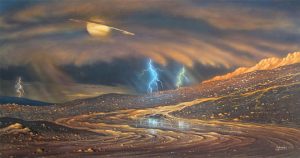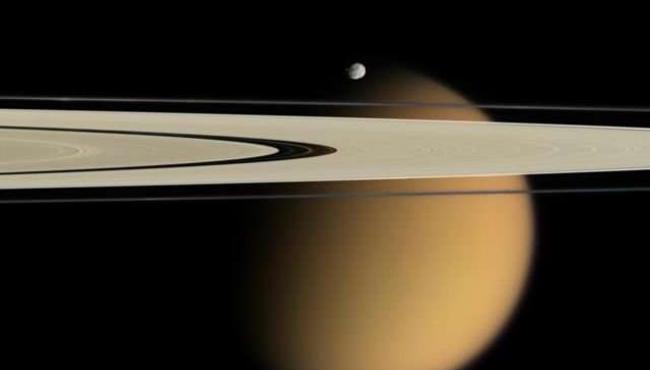
Heavy Rainstorms With Hybrid Ice Detected On Saturn’s Largest Moon Titan
Based on the data from NASA’s Cassini Mission, Scientists have found that methane rainstorms are playing a key role in shaping Titan’s icy surface. They have found an evidence of a toxic hybrid ice in a wispy cloud high above the south pole of ringed planets largest moon, Titan.
The finding is a new demonstration of the complex chemistry occurring in Titans atmosphere, in this case, cloud formation in the giant moons stratosphere and part of a collection of processes that ultimately helps deliver a smorgasbord of organic molecules to Titans surface.

Of all the moons in our solar system, Titan is the only one known to have liquids flowing across its surface, making it in some ways similar to our Earth. But unlike Earth, Titan’s liquid reservoirs are made up of methane, not water.
Invisible to the human eye, the cloud was detected at infrared wavelengths by the Composite Infrared Spectrometer (CIRS) on the Cassini spacecraft. Located at an altitude of about 160 to 210 kilometers, the cloud is far above the methane rain clouds of Titans troposphere, or lowest region of the atmosphere.
And much of this has to do with surprisingly intense methane rainstorms that occur more frequently than the scientists anticipated. Titan, Saturn’s largest moon, experiences extreme methane rainstorms once every year, which is 29 and a half years here on Earth.

The new cloud covers a large area near the south pole, from about 75 to 85 degrees south latitude. Laboratory experiments were used to find a chemical mixture that matched the clouds spectral signature – the chemical fingerprint measured by the CIRS instrument. The experiments determined that the exotic ice in the cloud is a combination of the simple organic molecule hydrogen cyanide together with the large ring-shaped chemical benzene.
Researchers have also found that Titan’s methane rainstorms may affect the moon’s icy surface in a way more like that extreme rainstorms shape Earth’s rocky surface. On Earth, intense storms form cone-shaped features called alluvial fans. Alluvial fans are created when flowing waterfalls into low lands and interact with sediments.

The two chemicals appear to have condensed at the same time to form ice particles, rather than one being layered on top of the other. “This cloud represents a new chemical formula of ice in Titans atmosphere,” said Carrie Anderson of NASA’s Goddard Space Flight Center in the US. “Whats interesting is that this noxious ice is made of two molecules that condensed together out of a rich mixture of gases at the south pole,” said Anderson.
The mission came to an epic end last month when the spacecraft crashed and burned into the planet’s atmosphere. Researchers have found that the alluvial fans are mostly located between 50 and 80 degrees latitude, slightly closer to the poles than to the equator. Although researchers have had kept their eyes on Titan’s surface for many years, no previous study had investigated the behavior of extreme rainfalls on the moon or shown their connection to surface observations.
The researchers expect them to be lumpy and disorderly, rather than well- defined crystals. The Cassini spacecraft ended its Saturn mission on September 15 by crashing into the planet.